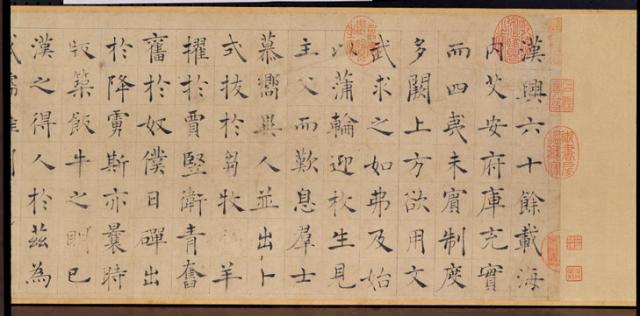唐褚遂良書倪寬傳贊 卷
推薦分享
資源連結
連結到原始資料 (您即將開啟新視窗離開本站)後設資料
- 資料識別:
- 故書000054N000000000
- 資料類型:
- 類型:書法
- 型式:文字
- 著作者:
- 褚遂良(Chu Suiliang)
- 出版者:
- 數位化執行單位:國立故宮博物院
- 格式:
- 本幅 24.6x170.1公分、隔水一 24.6x11.1公分、隔水二 24.6x11.7公分、拖尾 24.6x151.3公分
- 語言:
- 漢文
- 關聯:
- 石渠寶笈初編(御書房),下冊,頁875&*故宮書畫錄(卷一),第一冊,頁6&*褚遂良(西元五九五-六五八年),錢塘(杭州)人,字登善。擅長隸書,甚得到當時書法名家歐陽詢的稱讚。由魏徵推薦與唐太宗討論書法。本卷字的筆劃疏瘦,運筆過程,一劃之間,有粗有細,字的姿態,有種翩翩自得,秀麗美妙,使人如面對一位一塵不染,清淨絕俗的高士。倪寬(?-西元前一○三年),千乘人。他善於處理法律案件。武帝執政時,有功於水利建設和年曆的制定。 褚遂良(西元五九六-六五九年),杭州錢塘人,人稱褚河南,為人耿直忠烈,高宗時因諫止武則天為皇后被貶死。 褚遂良的書法出自北碑,繼學虞世南和王羲之,終能在歐陽詢與虞世南之外,自創一體,成為初唐三大家之一。褚書用筆瘦勁,結體疏朗寬闊,筆劃富粗細的變化,優美的頓挫勾挑動作,更為褚書增加了一分嫵媚。此幅筆力稍弱,不見褚書直中帶曲的張力,可能是南宋的摹本。 褚遂良(西元五九六-六五八年),字登善,浙江錢塘人。善書法,早年學虞世南,後乃祖法王羲之,而能自成一家法。書體疏瘦勁鍊,清遠蕭散,微雜隸體,深獲太宗之器重,官至尚書右僕射,高宗即位,封河南郡公,世稱褚河南。 本幅書法筆意柔婉而富拙趣,歷代論者多認為是褚遂良晚年作品。近代學者則以其文中之避諱用字習慣,與唐代情況不類,而書體之用筆亦與褚書有所出入,結構較似歐體,認為是宋人臨寫。&*Ch'u Sui-liang, a native of Hangchow, excelled at clerical script and was praised by Ou-yang Hsün, a famous calligrapher of the time. Wei Cheng recommended him to Emperor T'ai-tsung. The characters here are thin and poen. However, within each character, some strokes are narrow while others thicker. The characters have a kind of light and airy effect that is both elegant and beautiful, as if one is looking at the pure and unsullied character of the calligrapher for which he was renowned. Ni K'uan (?-103 BC) was a native of Ch'ien-ch'eng. He excelled at handling legal cases. In the administration of Emperor Wu-ti, he was effective at designing flood control projects and devising calendrical systems.&*1.朱惠良,〈明錢溥跋唐褚遂良書倪寬傳贊〉,收入《雲間書派特展圖錄》(臺北:國立故宮博物院,1994年初版),頁130-131。 2.朱惠良,〈雲間書派特展簡介 — 錢溥跋唐褚遂良書倪寬傳贊〉,《故宮文物月刊》,第139期(1994年10月),頁82。 3.張光賓,〈故宮博物院收藏法書與碑帖〉,《故宮季刊》,第九卷第三期(1975年春),頁5-19。 &*褚遂良(西元五九六-六五八年),字登善,浙江錢塘人。善書法,早年學虞世南,後乃祖法王羲之,而能自成一家法。書體疏瘦勁鍊,清遠蕭散,微雜隸體,深獲太宗之器重,官至尚書右僕射,高宗即位,封河南郡公,世稱褚河南。 本幅書法筆意柔婉而富拙趣,歷代論者多認為是褚遂良晚年作品。近代學者則以其文中之避諱用字習慣,與唐代情況不類,而書體之用筆亦與褚書有所出入,結構較似歐體,認為是宋人臨寫。(20110913)&*Chu Suiliang (style name Dengshan), a native of Qiantang in Zhejiang, excelled at calligraphy. In his early years he studied the style of Yu Shinan but later turned back even further to Wang Xizhi to form a style of his own. Chu’s characters are sparse and thin yet strong and tempered for a pure and remote effect of desolate looseness mingled with elements of clerical script. Being greatly admired by Emperor Taizong, Chu served up to the post of Right Deputy Director of the Imperial Secretariat. When Gaozong assumed the throne, he was ennobled as the Duke of Henan Prefecture, becoming known to others as “Chu of Henan.” The brushwork in the calligraphy of this piece is soft and graceful yet full of simplicity. Critics through the ages generally regard this as a late work of Chu Suiliang. Recent scholars refer to Chu’s habit of using taboo characters in the text as dissimilar to that in the Tang dynasty as well as to the difference between the brushwork in the characters as differing from other accepted works by Chu. Along with the characters being more similar to Ouyang Xun’s, they use these as evidence that this work is a copy by a Song dynasty calligrapher.(20110913)
- 管理權:
- 國立故宮博物院
授權聯絡窗口
- 國立故宮博物院圖像授權、出版授權、影音資料授權-申請流程說明
http://www.npm.gov.tw/zh-TW/Article.aspx?sNo=03003061






